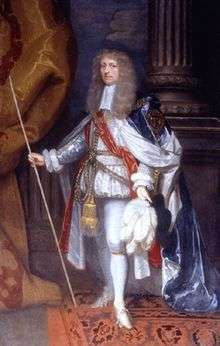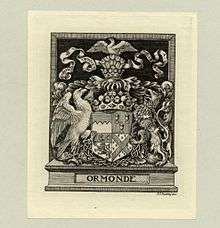Earl of Ormond (Ireland)
- For the titles in the Peerage of Scotland see: Earl of Ormond (Scotland)


The peerage title Earl of Ormond and the related titles Duke of Ormonde and Marquess of Ormonde have a long and complex history. An earldom of Ormond has been created three times in the Peerage of Ireland. It was originally created in 1328 for James Butler. The fifth earl was created Earl of Wiltshire (1449) in the Peerage of England, but he was attainted in 1461 and his peerages were declared forfeit. The earldom of Ormond was restored to his younger brother, John Butler, the sixth earl. The de facto, if not indeed the de jure earl, Piers Butler, was induced to resign his rights to the title in 1528. This facilitated the next creation by awarding the titles of Ormond and Wiltshire to Thomas Boleyn, who was the father of Anne Boleyn. At that time, Anne was the mistress of King Henry VIII of England. As a maternal grandson of the 7th Earl, Thomas Boleyn had a slim claim to the title. Through his daughter, Anne, he was the grandfather of Elizabeth I of England. On the death of Boleyn, these peerages of the second creation became extinct because he lacked male heirs, his son George having been executed for treason.
As a reward for his patriotism and generosity, Piers Butler, a cousin of the 7th Earl, was created Earl of Ossory five days after resigning his rights to the other titles. The third creation for Piers Butler (in 1538) merely recognised the reality of the situation prior to the Boleyn eruption. The fifth earl of this creation was made Marquess of Ormonde (1642) and Duke of Ormonde (1660) in the Peerage of Ireland, and Duke of Ormonde (1682) in the Peerage of England.
Other titles held by the earls
Prior to the creation of the Earldom of Ormond, the First Earl's father had been created the first Earl of Carrick. However, this title did not pass to James Butler. After a gap of 7 years following his father's death, James was rewarded with an earldom in his own right – Ormond. After 1682, the spelling "Ormonde" was used almost universally. Subsidiary titles for the duke were Earl of Brecknock (1660) and Baron Butler (1660) in the Peerage of England and Earl of Ormond (1328), Earl of Ossory (1538) and Viscount Thurles (1536) in the Peerage of Ireland. In 1715 the second duke was attainted and his English peerages declared forfeit. In 1758 the de jure third duke (Irish) died and the dukedom and marquessate became extinct. The eleventh earl was created the Marquess of Ormonde in the Peerage of Ireland in 1816, on his death that title became extinct and the earldoms passed to his brother, for whom the title Marquess of Ormonde was created in the Peerage of the United Kingdom in 1825. That title became extinct in 1997, while the earldom became dormant.
An unrelated Earldom of Ormonde was twice created in the Peerage of Scotland.
Earls of Ormond; First creation (1328)
- James Butler, 1st Earl of Ormond (c. 1305–1338)
- James Butler, 2nd Earl of Ormond (1331–1382)
- James Butler, 3rd Earl of Ormond (1361–1405)
- James Butler, 4th Earl of Ormond (1392–1452)
- James Butler, 5th Earl of Ormond and 1st Earl of Wiltshire (1420–1461)
- John Butler, 6th Earl of Ormond (1422–1478)
- Thomas Butler, 7th Earl of Ormond (c. 1426–1515)
Earls of Ormond; Second creation (1529)
Earls of Ormond; First creation (Reversed) / Third creation (1538)
- Piers Butler, 8th Earl of Ormond (1467–1539) (also 1st Earl of Ossory in 1528)
- James Butler, 9th Earl of Ormond (1496–1546) (also 1st Viscount Thurles in 1536)
- Thomas Butler, 10th Earl of Ormond (1532–1614). Distant cousin of Elizabeth I
- James Butler, Viscount Thurles (born 1584)
- Walter Butler, 11th Earl of Ormond (1569–1634)
- Thomas Butler, Viscount Thurles (died 1619)
- James Butler, 12th Earl of Ormonde (1610–1688) (created Duke of Ormonde in 1661)
Dukes of Ormonde (1661 Ireland and 1682 England)
- James Butler, 1st Duke of Ormonde (1610–1688)
- Thomas Butler, Viscount Thurles (c. 1632–1633)
- Thomas Butler, 6th Earl of Ossory (1634–1680)
- James Butler, 2nd Duke of Ormonde (1665–1745) (title forfeited in 1715, subsequently held to apply only to the English dukedom)
- Charles Butler, 3rd Duke of Ormonde (1671–1758) (Irish title held de jure unbeknownst to the holder)
Earls of Ormonde; First and Third creation (1328, 1538; Reverted)
- John Butler, 15th and 8th Earl of Ormonde (died 1766) (de jure)
- Walter Butler, 16th Earl of Ormonde (1703–1783) (de jure)
- John Butler, 17th Earl of Ormonde (1740–1795)
- Walter Butler, 18th Earl of Ormonde (1770–1820) (created Marquess of Ormonde in 1816)
Marquesses of Ormonde (1816)
- Walter Butler, 1st Marquess of Ormonde (1770–1820)
Earls of Ormonde; First and Third creation (1328, 1538; Reverted)
- James Wandesford Butler, 19th and 12th Earl of Ormonde (1777–1838) (created Marquess of Ormonde in 1825)
Marquesses of Ormonde (1825)
- James Wandesford Butler, 1st Marquess of Ormonde and 19th Earl of Ormonde (1777–1838)
- John Butler, 2nd Marquess of Ormonde and 20th Earl of Ormonde (1808–1854)
- James Edward William Theobald Butler, 3rd Marquess of Ormonde and 21st Earl of Ormonde (1844–1919)
- James Arthur Wellington Foley Butler, 4th Marquess of Ormonde and 22nd Earl of Ormonde (1849–1943)
- James George Anson Butler, 5th Marquess of Ormonde and 23rd Earl of Ormonde (1890–1949)
- James Anthony Butler, Viscount Thurles (1916–1940)
- James Arthur Norman Butler, 6th Marquess of Ormonde and 24th Earl of Ormonde (1893–1971)
- James Hubert Theobald Charles Butler, 7th Marquess of Ormonde and 25th Earl of Ormonde (1899–1997); earldoms dormant in 1997; marquessate extinct.
Earls of Ormonde and Ossory (1328/1538; Reverted)
The presumed successors of the 7th marquess in the Earldoms of Ormonde and Ossory have been the 17th and 18th Viscounts Mountgarret, descending in the male line from a younger son of the 8th Earl, but the claim has not been proved, because the possibility of male descendants of sons of the 9th earl has not been ruled out.
See also
References
External links
| Wikisource has the text of the 1911 Encyclopædia Britannica article Butler. |